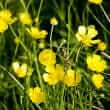Background
- Bulbous buttercup (Ranunculus bulbosus) is named for the uniquely bulbous, white protrusion that is found at the base of the stem. The common name "blister plant" comes from the blistering that occurs in the mouth and intestinal tract when cattle eat the plant.
- More than a century ago, bulbous buttercup was recommended by herbalists for resolving dermatologic, rheumatologic, gastrointestinal, and dental complaints. When rubbed on the skin, bulbous buttercup causes blistering, swelling, and topical ulcers, which were said to alleviate pain topically as well as subcutaneously. All parts of the acrid plants were used to induce vomiting and diarrhea upon ingestion. As a painkiller, the plant was stuffed into dental cavities and its infusions were rubbed on the gums of teething infants.
- Bulbous buttercup contains acrid, harsh chemicals that cause uncomfortable and severe reactions wherever it comes into contact with the body. Because of this, bulbous buttercup is not a frequently used herbal plant today. All parts of the bulbous buttercup are now known to be poisonous. The active properties of bulbous buttercup are thought to be destroyed upon heating or drying. There are no available high-quality clinical trials evaluating the use of bulbous buttercup for medicinal purposes.
References
Natural Standard developed the above evidence-based information based on a thorough systematic review of the available scientific articles. For comprehensive information about alternative and complementary therapies on the professional level, go to . Selected references are listed below.
- Kelch WJ, Kerr LA, Adair HS, et al. Suspected buttercup (Ranunculus bulbosus) toxicosis with secondary photosensitization in a Charolais heifer. Vet.Hum.Toxicol 1992;34(3):238-239.
View Abstract - Mares D. Antimicrobial activity of protoanemonin, a lactone from ranunculaceous plants. Mycopathologia 1987;98(3):133-140.
View Abstract - McGovern TW, Lawarre SR. Botanical briefs: buttercup Ranunculus species L. Cutis 2002;69(3):171-172.
View Abstract







